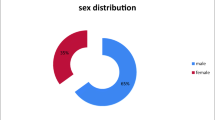Abstract
Introduction
Despite the improvement in surgical techniques in cleft palate surgery, oronasal fistulas continue to remain a challenge, usually the result of residual palatal and alveolar clefts and post-palatoplasty defects. The tongue flap is an extremely versatile, sturdy, reliable and efficient means of closure of anterior as well as posterior, unilateral and bilateral palatal defects, effectively functionally obliterating the oronasal communication, owing much of its success to its highly vascular structure, good mobility, texture match, central location and low donor site morbidity. However, it has a few drawbacks. Flap dehiscence and detachment during the early postoperative period is a troublesome complication owing to tongue movements during normal activities such as speaking, swallowing, yawning and coughing.
Aim
This article describes some of the methods which can be used to effectively alleviate these shortcomings.
Methods
A protocol of immobilizing the tongue by tethering it to the maxillary teeth for the 3-week postoperative period, and also maintaining the patient on nasogastric feeding, until the patient is taken up for surgical separation the pedicle, was employed in all patients in this case series.
Results
There was a successful and predictable take of the tongue flap at the donor site, namely the palatal/oronasal fistula with its successful closure, in all the patients.
Conclusion
Treatment of the oronasal fistula using a two-layer closure using the nasal mucoperiosteum together with an anteriorly based dorsal tongue flap is an easy and efficient method, whose reliability can be further increased by avoiding a common complication, namely tongue flap detachment in the postoperative period brought on by movements of the tongue, by immobilizing the tongue by tethering it to the maxillary teeth and also maintaining the patient on nasogastric feeding for the 3-week postoperative period.


Similar content being viewed by others
References
Amaratunga NA (1988) Occurrence of oronasal fistulas in operated cleft palate patients. J Oral Maxillofac Surg 46:834–837
Cohen SR, Kalinowski J, LaRossa D, Randall P (1991) Cleft palate fistulas: a multivariate statistical analysis of prevalence, etiology and surgical management. Plast Reconstr Surg 87:1041–1049
Sadhu P (2009) Oronasal fistula in cleft palate surgery. Indian J Plast Surg 42:123–128
Nakakita N, Maeda K, Ando S, Ojimi H, Utsugi R (1990) Use of a buccal musculomucosal flap to close palatal fistulae after cleft palate repair. Br J Plast Surg 43:452–456
Sarabahi S, Tiwari VK (2006) Orbicularis oris musculomucosal flap for anterior palatal fistula. Indian J Plast Surg 39:148–151
Guerrero-Santos J, Altamirano JT (1966) The use of lingual flaps in re-pair of fistulas of the hard palate. Plast Reconstr Surg 38:123–124
Assuncao AGA (1993) The design of tongue flaps for the closure of palatal fistulas. Plast Reconstr Surg 91:806–810
Awang MN (1988) Closure of oroantral fistula. Int J Oral Maxillofac Surg 17:110–113
El Hakim IE, el Fakharany AM (1999) The use of the pedicled buccal fat pad (BFP) and palatal rotating flaps in closure of oroantral communication and palatal defects. J Laryngol Otol 113:834–837
Barone CM (1993) Refinements of the tongue flap for closure of difficult palatal fistulas. J Craniofac Surg 4:109–111
Busic N, Bagatin D, Boric V (1989) Tongue flaps in repair of large palatal defects. Int J Oral Maxillofac Surg 18:291–293
Kim YK, Yeo HH, Kim SG (1998) Use of the tongue flap for intraoral reconstruction: a report of 16 cases. J Oral Maxillofac Surg 56:716–718
Guerrero-Santos J, Fernandez JM (1973) Further experience with tongue flaps in cleft palate repair. Cleft Palate J 10:192–202
Nawfal F, Hicham B, Achraf B, Rachid B (2014) Repair of large palatal fistula using tongue flap. Afr J Paediatr Surg 11:82–83
Steinhauser EW (1982) Experience with dorsal tongue flaps for closure of defects of the hard palate. J Oral Maxillofac Surg 40:787–789
Elyassi AR, Helling ER, Closmann JJ (2011) Closure of difficult palatal fistulas using a “parachuting and anchoring” technique with the tongue flap. Oral Surg Oral Med Oral Pathol Oral Radiol Endodontol 112:711–714
Kuran I, Sadiko_glu B, Turan T, Hacikerim S (2000) The sandwich technique for closure of a palatal fistula. Ann Plast Surg 45:434–437
Vasishta SMS, Krishnan G, Rai YS, Desai A (2012) The versatility of the tongue flap in the closure of palatal fistula. Craniomaxillofac Trauma Reconstr 5(3):145–160
Agrawal K, Panda KN (2007) Management of a detached flap. Plast Reconstr Surg 120:151–156
Author information
Authors and Affiliations
Corresponding author
Ethics declarations
Conflict of interest
The author of this article has not received any research grant, remuneration or speaker honorarium from any company or committee whatsoever, and neither owns any stock in any company. The author declares that she does not have any conflict of interest.
Ethical Standards
All procedures performed on the patients (human participants) involved were in accordance with the ethical standards of the institution and/or national research committee, as well as with the 1964 Helsinki Declaration and its later amendments and comparable ethical standards.
Human and Animals Rights
This article does not contain any new studies with human participants or animals performed by the author.
Informed Consent
Informed consent was obtained from all the individual participants in this study.
Rights and permissions
About this article
Cite this article
Jeyaraj, C.P. Techniques to Improve Reliability and Predictability of the Dorsal Pedicled Tongue Flap in Closure of Palatal Defects and Oronasal Fistulae. J. Maxillofac. Oral Surg. 17, 175–181 (2018). https://doi.org/10.1007/s12663-017-1035-6
Received:
Accepted:
Published:
Issue Date:
DOI: https://doi.org/10.1007/s12663-017-1035-6




